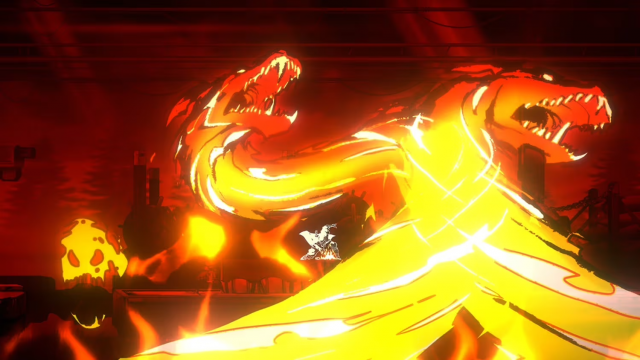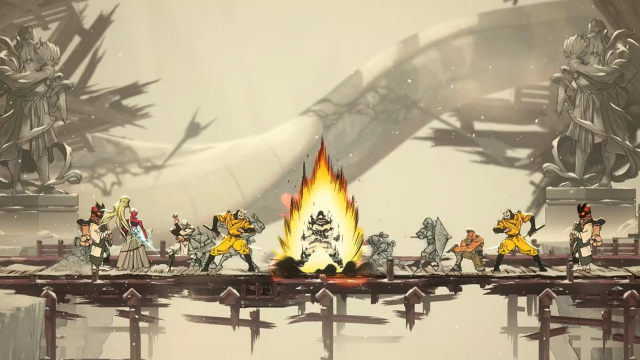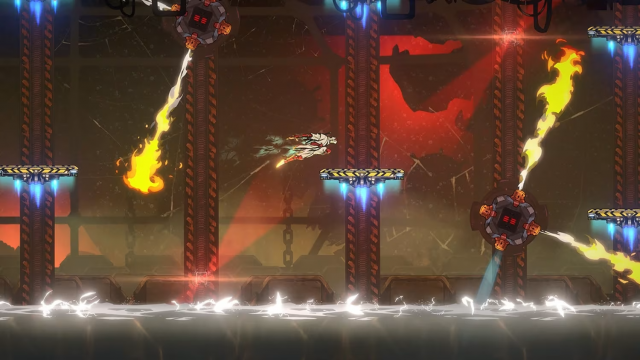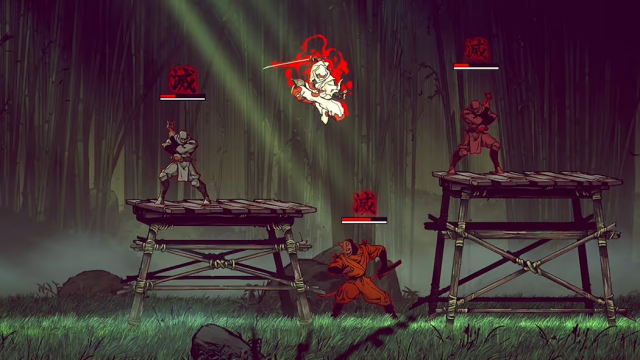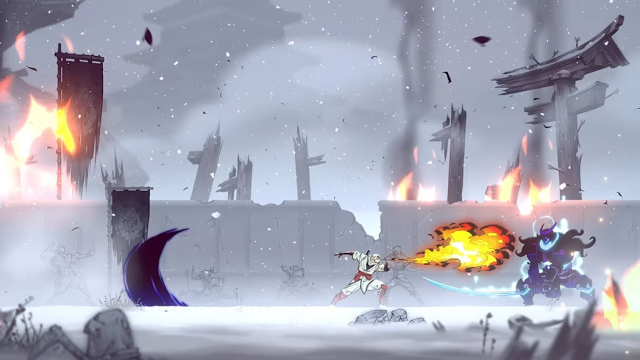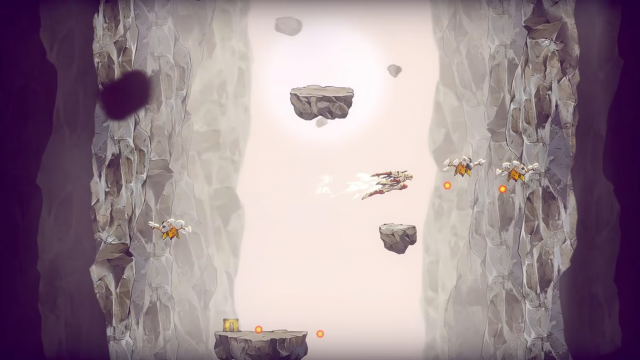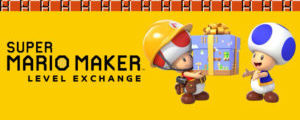Consistently gorgeous and varied visuals; Joe’s moveset feels great; Tasteful fanservice
Metroidvania structure gets in the way; Enemies can’t provide much of a challenge; Not much here for a Shinobi veteran
For generations, Sonic the Hedgehog has been synonymous with SEGA’s brand, but he wasn’t always the top dog (top hog?). SEGA’s first attempt at a console mascot was the simultaneously elfin and chubby Alex Kidd. Alex had trouble finding a mechanical identity. In one game, he’s playing Rock, Paper, Scissors with bosses instead of fighting them, in another he’s just BMX racing, in a third he’s navigating giant houses, and in a fourth he’s just a ninja. That last one, Alex Kidd in Shinobi World, was an acknowledgement that nobody really wanted Alex Kidd games anymore and that the torch had been passed to a new contender: Joe Musashi of the Shinobi series.
Joe Musashi has himself long since passed the torch and passed out of mainstream cultural relevance, but SEGA’s been in a nostalgic mood as of late. Lizardcube, the French developer who previously turned out a well-regarded sequel to a SEGA classic with Streets of Rage 4, is back to hopefully continue its hot streak with Shinobi: Art of Vengeance, a successor to the series’ golden era on Genesis.
While there were mechanical changes from one classic Shinobi game to the next, there was also a great deal of shared identity across the set, culminating in the Genesis swan song and definitive Shinobi title, Shinobi III: Return of the Ninja Master. Ever since, when people have described other games as “like Shinobi” (e.g. Hagane, Ganryu II, or Vengeful Guardian Moonrider), they have meant Shinobi III specifically.
Aside from the obvious ninja aesthetics and story/character concepts, the signatures of the Shinobi series include:
- Linear stages with aggressive and obstructing enemies that make the player fight for progress one foot at a time, with time pressure forcing the player to actually engage with that challenge
- A high-commitment moveset where every option has both upsides and downsides and the player can’t just wing it or style on enemies like they’re sandbags
- Ranged combat as the default option or at least an equal partner to melee combat
- Persistent resource management (for kunai, ninpo, extra lives, and HP), with decisions and player performance in one stage affecting the player’s options in the next
An obvious question to ask, then, is how Art of Vengeance follows on from Shinobi III mechanically. So let’s ask it: how does Art of Vengeance fit into this legacy?
Joe Musashi in Metroidvania World
Lizardcube has given us a game with:
- Sprawling stages with relatively few enemies outside of dedicated combat arenas, with branching paths and keys/locks that necessitate running around and backtracking
- A gratuitously powerful moveset that includes an oppressive divekick that 90% of enemies have no counter to, plus a generous i-frame dodge, copious aerial mobility, and a parry too for good measure
- Melee combat almost completely crowding out ranged combat
- No meaningful resource management outside of the postgame boss rush specifically
Of course, this all makes sense from a market perspective. Neither Ganryu II nor Vengeful Guardian Moonrider make sense as templates for SEGA and Lizardcube to follow if what they’re after is mainstream success. It is a miracle that we got one major publisher’s 2D ninja game this year that managed to escape being some combination of metroidvania, roguelite, and/or soulslike. That the other is a metroidvania shouldn’t be too surprising – look at the release date blast zone created by Silksong. Metroidvanias are what the people want, so Shinobi needed to be disassembled and reassembled into a metroidvania, like Strider was a decade ago. While it might disappoint players who liked Shinobi for its gameplay more than its cool ninja aesthetics, that doesn’t mean it can’t be a good game. Is it?
Early Peaks, Late Valleys
On a first playthrough, Art of Vengeance is a very comfy ride. There’s a ton of visual and mechanical variety from one stage to the next, it’s all drop dead gorgeous, Joe’s moveset feels great in the hand, there are a ton of tasteful references for the oldheads, and the metroidvania-style stages are relatively lean by metroidvania standards, buoyed by a map screen that does a good job of delineating secrets vs the critical path.
But even on a naive “go with the flow” first playthrough, the pacing starts to suffer in the final set of stages, which significantly increase the branching and backtrack-happy stage designs that had previously been kept under control. Additionally, the game saves its worst traversal ability unlock (slow gliding) for last, and it does damage not just to the pace of the levels as a whole but to the pace of individual screens. This negates what had been a strength of Art of Vengeance’s design compared to the classic entries, which is the kinetic feeling of forward motion.
The critical path through each stage is surprisingly mellow, both in terms of platforming and combat. When the platforming gets serious, it’s in side sections that tend to be completely free of combat, and vice versa — the serious combat sections tend to have very light platforming if any. That’s unfortunate in that the game is at its best when these are more intensely mixed (e.g. combat arenas with dynamic stage hazards), but that’s surprisingly rare. Still, even without a real synthesis of the combat and the platforming, each feels good in isolation.
While the metroidvania platforming kit is pretty much an off-the-rack affair (double jump, air dash, wall jumps, anchor points to grapple-jump from, ceiling/wall-crawling, the aforementioned slow glide, a ground pound to break floors, etc.), combat warrants further discussion as it seems like it’s received more developer and audience attention than any other aspect of the game (aside from Ben Fiquet’s incomparable art direction, which to be honest is really the star of the show).
Unlike in classic Shinobi games, which give the player a combat toolkit and opponents that can easily match it, allowing Joe to either overpower his enemies or get bodied (depending on player skill), in Art of Vengeance Joe is just ridiculously overpowered and the enemies undertuned. It’s not surprising that popcorn enemies can be quickly dispatched; the role of an enemy like that (after a tutorial) is to complicate other encounters, not go toe to toe. Nor is it a problem that all of the hardier enemies telegraph their moves so clearly, but it is a problem that reacting to those telegraphs and punishing them is so easy. In the recent NINJA GAIDEN: Ragebound, for example, the player’s attack opportunities are often short and the vectors by which they can approach are constrained, so there is a tension and thrill to making the most of these moments.
In Art of Vengeance, by contrast, the player can just jump or double jump to avoid damage, then mash the heavy attack button to divekick and follow up with an additional combo. This is generally enough to kill or at least stagger and juggle all but the most durable enemy. There are shielded enemies, sure, but that just requires double jumping over them (or walking through them) before the divekick. And there are rare enemies with anti-air options, yes, but those just require air dashing through their anti-air before divekicking from behind.
Nor are the wide openings the only problem; Joe’s Wind Slash Ninpo can clear out whole screens of enemies cheaply when paired with the easily obtained Wind Sculptor accessory, for example. And even if the player decides to largely duke it out on the ground, enemy telegraphs are so slow, the game constantly gives the player moments to reassess due to excessive hitstop, and Joe’s movements are so fast and easily transitioned into a dodge that at times it feels like the game has to get Joe’s permission to do damage to him.
At no point is the game unpleasant to play, but there are so many wasted opportunities. Art of Vengeance introduces an execution mechanic to the series, where an enemy that has been badly damaged but left alive can be harvested later via a teleporting assassination move. If you save up several wounded enemies to harvest at once, you get more resources from all of them. The problem, of course, is that the game never presents a challenge that makes those increased resources relevant, so the mechanic is largely a curiosity.
The most interesting thing that I saw happen with the execution mechanic across 20 hours of play was one time when I got knocked off a ledge in an arena fight and was able to use the execution move to teleport back to terra firma. Even though all that was at stake was maybe one tenth of my health bar, that was still a really cool and clutch moment.
A player with average skill with metroidvanias or other action platformers will probably manage to kill at least half of the bosses on their first attempt, which is disappointing, but it is worth saying that it feels sick as hell to divekick bosses and slash them to ribbons, even if these are the empty calories of action game design.
What About Endgame?
This is all fair as far as it goes — Lizardcube likely was aiming to prioritize power fantasy above any other considerations when designing the combat system — but it doesn’t explain why there isn’t any kind of hard mode. It’s bad enough that no hard mode is available at the outset. That’s bad practice regardless of the game, but doubly so when the game is a sequel in a series famous for being challenging. Legacy Shinobi fans are going to come to this game with their legacy skill, and they are going to roll through the villain Lord Ruse’s army as easily as Joe Musashi himself. Sincerely, that’s cute, unbalancing the game to support the cliche “how is he doing this — he’s just one man!?” story, but at minimum there should have been a hard mode unlock, something at the end of the rainbow.
What does unlock after the endgame is one superboss, a boss rush mode, and the option to play the stages in Arcade Mode for rank.
The superboss is a much-appreciated bit of Shinobi III fanservice, but the difficulty is honestly not particularly high for the effort the player has to go through to unlock it. Perhaps the upcoming DLC bosses will present more of a challenge.
The boss rush mode, honestly, is the most faithful Shinobi experience in the entire game. No cul de sacs to explore, no checkpoints to restore health, no infinite retries for each morsel of challenge. The player has to make hard decisions about where they want to save or spend their ninpo or kunai, or when it’s safe to go for another hit before dodging, given that they have to do the entire boss rush on one lifebar. For one shining combat challenge, the dynamics of classic arcade-influenced design escape the all-encompassing, creeping shadow of metroidvanias and modern “best practices.”
Finally, Arcade Mode is basically just a full replay of the stages as they were, seemingly not remixed or adjusted except that the optional Ankou Rift challenges are removed and all collectibles are replaced with crests that contribute to rank. Rank is affected by various factors like speed, number of kills, execution chain, number of crests picked up, and especially by whether the player avoids damage. The problem with this mode is that it really highlights that the stages were designed around exploration more than proper flow. It’s okay in the first couple of stages, but even by The Mountain the cracks show.
Stages are overly long and oscillate between boring corridors that the player spams the dodge roll in to dash through on the one hand, and combat arenas or platforming gauntlets on the other. It feels strangely like a farming route to grind materials in an action RPG, rather than a coherent level with a carefully designed flow. Go through the empty bit, then do a spot of real gameplay, then go through another empty bit.
A Note on Audio
Unfortunately, the game’s audio presentation does not come close to matching its sumptuous visuals. The music – composed by Tee Lopes with some featured tracks by series veteran Yuzo Koshiro – is more than fine, but doesn’t come close to matching the quality suggested by those names, nor does it come close to the compositions from the Genesis entries, including those composed by Koshiro. Halfway through the game, before I looked up the composers, I found myself thinking, “man, too bad they didn’t get Koshiro back for this one.” The game’s default mixing doesn’t do it any favors either, and I would strongly recommend turning the sound effects down in the mix to give the music a better chance of shining through.
That won’t help with the Saturday morning cartoon vibe of the English voices, which feel like a bad match for the art. The art is of course stylized with various anime, comic, or even cartoon influences, but that’s done to such a high level of quality and stylishness that the English voices are frankly jarring in comparison. Setting aside matters of taste, there are other problems with the localization. The English voices can’t seem to decide whether the name of Joe’s ninja clan is stressed like “oh-BOH-roh” or “OH-bo-ro” — a gaffe that was clear in the demo and hasn’t been addressed in the retail release. And unlike in the Japanese, in English they use the same voice actor for the character The Ankou as they do for the narrator, and he sounds exactly the same in both roles. You might expect that we’re supposed to think that The Ankou is thus the narrator, but the script was not written to acknowledge it (we get dialogue by The Ankou followed immediately by the narrator talking about The Ankou in third person). In Japanese the voice actors differ so I am inclined to interpret this as unintentional.
Is It Worth It?
Yes, it’s a compromised product that the player will likely outgrow soon after rolling credits, and there are some deep problems with the combat and level design, but Art of Vengeance feels great in the hand, and the moment to moment play variety plus the frankly world class visuals are enough to succeed on spectacle. It could have been better, Shinobi III deserved to be treated as more than an aesthetic theme, and it’s not nearly as well-considered a successor as Streets of Rage 4 was. But the game is still solidly recommended for anyone who likes the idea of a metroidvania with an overpowered ninja protagonist.
This review is part of our Year of the Ninja celebrations where we recognize the thrilling comeback of the ninja game and honor the impact these titles have had on the history of the video game industry. To learn more, click here.




 ShareThis
ShareThis